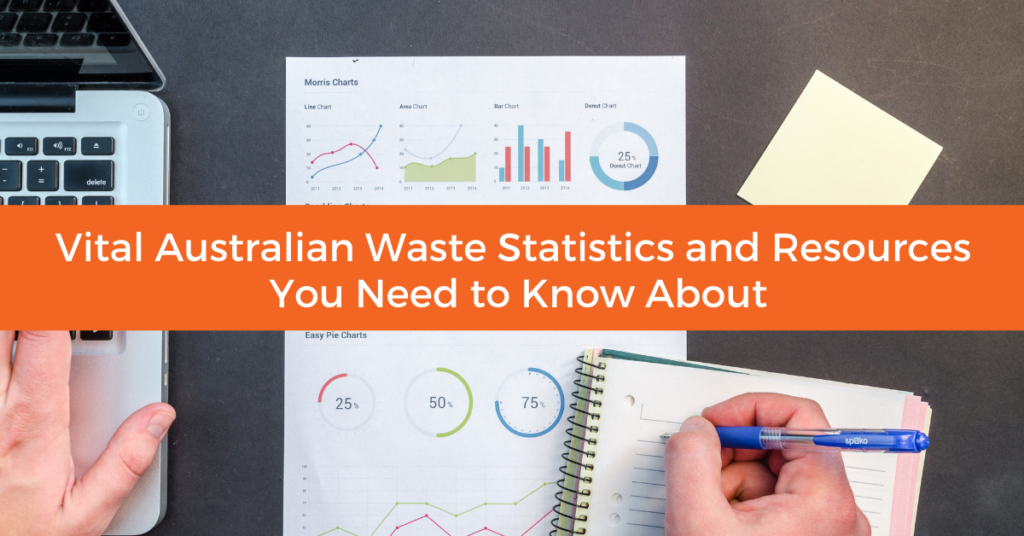
What Waste Facilities and Councils Can Learn from Statistics on the Industry, Community Attitudes & Behaviours Towards Waste
Right across Australia, waste facilities and councils are actively putting initiatives and measures in place to educate the public on proper waste disposal behaviours and to improve their waste services. But to put such plans in place, it always helps to have statistics and resources to refer to about current industry trends and waste behaviours. When you have solid data in place to back up the actions you take, you’re more likely to achieve the outcome you want.
With this in mind, we have done our research and found a stack of resources and statistics that reflect industry trends and challenges along with resident attitudes and behaviours towards waste within Australia. We hope that your council and/or facility can learn from this information and grow in a way that accurately reflects what the community needs.
So, what kind of information is currently out there for this topic? Let’s find out.
Here is a full list of the resources we will be covering in this blog:
- 2019 Food Waste Australian Household Attitudes and Behaviours National Benchmarking Study
- 2019 Australian Senate Report on Waste
- 2018 National Waste Policy
- 2018 National Waste Report
- Analysis of Australia’s Municipal Recycling Infrastructure Capacity 2018
- KPMG Smart Cities – a Snapshot of Australia in 2019
- ABS – Environmental Views and Behaviour – 2011-2012
- Being Wise with Waste – The EU’s approach to waste management
- Inside Waste – The State of Waste in Australia – a 2019 review
- Australians create 67 million tonnes of waste each year. Here’s where it all ends up – ABC Dec 2019
2019 Food Waste Australian Household Attitudes and Behaviours National Benchmarking Study
The purpose of the 2019 Food Waste National Benchmarking Study is to establish a national baseline on current community knowledge, attitudes and behaviours around household food management and food waste.
A total of 5,272 people were surveyed across all 8 states.
Here are some of the insightful statistics you can learn in this report:
- 34% of Australian food waste is generated in households.
- 47% threw away fresh vegetables and herbs.
- 73% reported no prepared food wastage and this includes takeaway and home-delivery.
- The combined reported food waste per household on average over 7 days equated to 2.65 litres.
- A gap between self-estimates and real food waste numbers was reported by waste bin audits, which showed 7.81 litres of food waste disposed of in kerbside bins.
- 42% of household food managers said they were very motivated and 34% fairly motivated to reduce their food waste.
- Saving money is the biggest motivator for food waste reduction at 51% followed by doing the right thing at 18% and saving the planet at 16%.
- 61% dispose of food waste in the general waste bin, 25% use a compost system managed at home or worm farm and 21% make use of kerbside green organic/food disposal bins.
These statistics seem to show that there is an incorrect perception of how much food waste is being disposed of, and this could be a catalyst for a potential education campaign encouraging people to think about and track their food waste to not only realise how much food they are wasting but to change their habits in the process.
With a majority of respondents already motivated to reduce their food waste, the effectiveness of such a campaign to further fuel this motivation is evident. Green/organic food disposal bins and compost initiatives also seem to be worthwhile areas to focus on for improvement.
2019 Australian Senate Report on Waste
It’s important to know current industry perceptions and the path the Australian government is planning to take the waste industry down as the policies created will no doubt have a huge impact. This senate report from 2019 focusing on the waste and recycling industry in Australia clearly lists 18 recommendations at the very top of the document with the first three being:
- For the Australian Government to prioritise the establishment of a circular economy in which materials are used, collected, recovered, and re-used, including within Australia.
- For the Australian Government to show leadership through the urgent implementation of the 16 strategies established under the National Waste Policy.
- For the Australian Government to prioritise waste reduction and recycling above waste-to-energy, and seek a commitment through the Meeting of Environment Ministers of all levels of government to the waste hierarchy.
Some insightful facts and information can also be found in this document such as:
- Waste levies have been shown to have a limited impact on reducing the waste generated by ratepayers, as they have no direct financial incentive to reduce waste going to landfill.
- Householders have enthusiastically embraced kerbside recycling programs as demonstrated by the large quantities of recyclable material collected.
- In excess of two million mattresses are sold every year. 1.6 to 1.8 million mattresses are disposed of with more than half of these going to landfill. With the appropriate collection and processing systems, mattresses are (almost) fully recoverable.
We recommend downloading a copy and reading all of the recommendations and statistics to get an idea of what future plans may be ahead.
2018 National Waste Policy
The 2018 National Waste Policy was prepared by the Australian Government, state and territory governments and the Australian Local Government Association. The purpose of this policy is to provide a framework for collective action by businesses, governments, communities and individuals until 2030 and encourage everyone to work together to improve waste management in Australia.
Along with including valuable statistics and resources, this policy explains why Australia needs a national waste policy, it contains incredibly useful visual diagrams such as Australian waste flows along with 14 well thought out strategies on applying circular economy principles for waste, recycling and resource recovery.
Here are just a few of the useful insights you can gain from this policy document:
- Since 2006, the amount of waste generated per person in Australia had declined by 10%.
- The recovery rate (which includes recycling and energy recovery from waste) has increased from 50% in 2006-07 to 58% in 2016-17.
- For every 10,000 tonnes of recycled waste, 9.2 jobs are created (compared with 2.8 jobs if the same amount of waste goes to landfill).
- Waste-related activities added a total value of $6.9 billion to the economy accounting for 0.43% of GDP.
- Around 50,000 people are directly employed in waste related activities.
2018 National Waste Report
This report prepared for the Department of the Environment and Energy contains a summary of the status of waste in Australia during 2016-17 along with data on waste generation, source streams, materials and fates.
This 126 page wealth of knowledge covers a wide range of Australian waste industry topics such as waste generation, recycling, energy recovery, waste material analysis, local government waste management and so much more. This is absolutely a worthwhile resource for anyone in the Australian waste industry to have on hand.
Here’s our selection of some of the best facts, figures and insights that can be gained from this document primarily focused on community and resident behaviours and attitudes towards waste:
- Over an 11 year timeframe, recycling of construction and demolition waste grew by 34%.
- Municipal Solid Waste recycling increased by 31% over 11 years which can be attributed to improved access to recycling services, including organics bins.
- Despite strong population growth, total disposal quantities have fallen by 11% over 11 years due to declining per capita rates of waste to landfill.
- Despite a trend across Australia for increased recovery rates, in recent years the recovery rates for Qld, NSW and Vic seem to have fallen slightly. The falls are partly due to a decline in landfill gas recovery.
- As of 2016-17, about 95% of Australians had a kerbside garbage bin service, 91% had a recycling bin and 42% had an organics bin, plus anyone without a kerbside service usually had access to drop-off services.
- Contamination rates in recycling bins typically range between 4- 12% by weight, depending on enforcement and education efforts and the socio-economic characteristics of the area.
- Approximately 95% of Victorian beachside litter is from urban areas and carried to the sea by stormwater.
- Annual litter surveys suggest a decline in the number of littered items, particularly cigarette butts and paper. This may reflect a reduction in smoking and print media combined with effective litter prevention and community engagement.
- Australia spent about $70 million cleaning up dumped waste in 2016-17.
- Litter surveys and anecdotal reports suggest container deposit schemes reduce litter and improve recycling in regional and remote communities.
- Across Australia, food and garden organics make up about half of kerbside garbage and a quarter of commercial garbage.
- Australia continues to rely on relatively basic waste technologies compared to many countries, particularly in western Europe.
- The case for energy from waste is stronger where it is demonstrated as a last resort option above landfill, but below higher options on the waste hierarchy of avoidance and reduction, reuse and recycling.
- High-profile media coverage and political lobbying for bans on single use plastic bags and drinking straws have resulted in the introduction of legislation to ban single use bags across multiple states, and major retailers phasing out single use bags.
- The shift from paper to digital communications is greatly reducing paper wastage.
- High strength but light weight packaging is decreasing the weight of our recycling bins. As packaging gets lighter, weight could decline while volume increases.
- The long-term trend in waste management is towards increasing levels of recycling and, driven by public demand and government policy, there is little reason to imagine this will change.
Analysis of Australia’s Municipal Recycling Infrastructure Capacity 2018
This report licensed by the Commonwealth of Australia includes targeted assessments of recycled materials flows from municipal sources through collection and recycling.
While this is a hefty report at 139 pages, within it you will find a simple summary of findings at the very beginning followed by more detailed information on the collection and processing of municipal waste in Australia. It then concludes with the challenges and opportunities for municipal recycling infrastructure in Australia.
This report uses statistics gained from the National Waste Report 2018 among others and repurposes the information into a comprehensive and clear analysis.
Here are some of the insights and findings found within this report:
- The total volume of Australia’s municipal waste is increasing, and the quality of some recovered materials is diminishing.
- Few sorting facilities are equipped to process co-mingled municipal waste in a way that enables assured, sorted flows of uncontaminated plastics, paper and cardboard.
- Opportunities exist to increase Australia’s capacity to manage organic waste, including through the provision of new infrastructure supporting kerbside collection of organic material, and processing those organics into compost and other products.
- Improving regional and remote kerbside collection services across Australia will improve waste management and increase opportunities for recycling in these areas.
As this is focused on analysis, you are likely to get clearer outlines of challenges and glean more actionable solutions to common waste challenges within this document compared to other more statistics-heavy reports.
KPMG Smart Cities – A Snapshot of Australia in 2019
The primary focus of this report is on Smart Cities in Australia. This report presents the key trends, insights and case studies captured during the Smart Cities Series by KPMG which travelled across five cities in Australia in 2019 and the Public Sector Network.
Here are some of the key insights and findings within the report:
- While the majority of councils are in the strategy development stage for Smart Cities, the number of local governments piloting projects is notably higher this year at 21 percent which is up from 11 percent in 2018.
- The top Smart City project planning occurring for 2019 is centred around ‘Platform’ at 19%. This is up from 14 percent in 2018. A focus on platform enables governments to gain a single view of their customers and deliver more efficient, responsive and personalised services.
- The days of operating under the assumption of ‘build it and they will come’ are gone. Instead, government leaders are adopting a peoplefirst approach to Smart City transformation.
- The complexity involved in developing a Smart City can only be effectively tackled when a diverse range of stakeholders collaborate and share their expertise, experience and resources.
ABS – Environmental Views and Behaviour – 2011-2012
While this data may be 8-9 years old, the size of the data set and quality of information gained about waste behaviour from the ABS makes this a worthy consideration. The aim of this study was to gain data on waste collection and disposal behaviours nation-wide.
Here are some of the key takeaways that can be gained from this data:
- 83% of Australians were satisfied with their waste collection services in 2011
- 86% of Australians living in capital cities were more likely to be satisfied with their waste collection services compared with 78% of those living outside of capital city areas.
- Of those who were not satisfied with their current waste collection service, 46% had inadequate or non-existent services for the disposal of waste materials such as green waste or hard rubbish.
- 3/4 of Australians stated they always sort their recyclable waste from their non-recyclable waste.
- 78% of people living in capital cities were more likely to always sort their recyclable waste from their non-recyclable waste compared to 69% of people living outside of capital city areas.
- Over a third of Australians (35%) always compost or recycle garden waste.
This data shows a strong satisfaction level for waste collection services in Australia with additional green waste or hard rubbish services being opportunities to further improve satisfaction for councils that do not offer such services.
Additional Resources
While this data may be 8-9 years old, the size of the data set and quality of information gained about waste behaviour from the ABS makes this a worthy consideration. The aim of this study was to gain data on waste collection and disposal behaviours nation-wide.
Here are a few notable mentions worth exploring to further expand your waste resources collection:
Being Wise with Waste – The EU’s approach to waste management
This report is about dealing with waste in the European Union. It provides some good insights on the challenges of waste and approach to waste management from an international perspective.
Inside Waste – The State of Waste in Australia – a 2019 review
In 2019 Inside Waste created this article which reviewed the state of waste in Australia. This article summarises many of the statistics and points raised in some of the above-mentioned reports to provide an insightful overview of what waste looks like in Australia.
Australians create 67 million tonnes of waste each year. Here’s where it all ends up – ABC Dec 2019
This visual and easy to follow article created by the ABC in December 2019 touches on a number of waste topics including the recycling process, why recycling is sent to landfill, waste exports to China and what’s being done to deal with the waste in Australia. This is a wonderful community education piece for the general public to read.
What Can Waste Facilities and Councils Learn from this Information?
By gaining a better understanding of current industry-wide practices, upcoming trends, government policies, challenges and community attitudes and behaviours towards waste, you’ll be better equipped to future proof your facility operations and council initiatives and become part of the solution when overcoming waste challenges being faced nation-wide.


